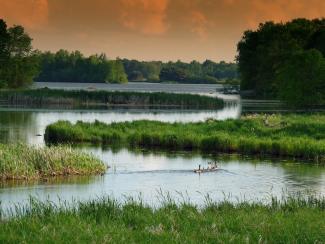Not long after the Clean Water Act (CWA) became the law of the land on October 18, 1972, providing the basic structure for regulating pollutant discharges into the waters of the United States (WOTUS), bureaucratic battle lines were drawn at the newly created U.S. Environmental Protection Agency.

At EPA headquarters, the West Tower primarily housed the Administration. William D. (Bill) Ruckelshaus, the first and fifth EPA Administrator, and his Deputy Administrator Robert W. Fri had their offices on the West Tower’s 12th Floor, which was accessible only by a “very small” private elevator.
Meanwhile, the majority of the program offices (including the Office of Water) were located in the East Tower. The Waterside Mall served as the connector between the two towers, a long haul, especially when decisions needed to be made expeditiously. Communication could be frustrating, particularly for program personnel in need of management’s approval for its initiatives. While this may seem trivial now, it was a regular impediment to the early management and program implementation processes.
When the CWA was enacted over President Nixon’s veto, the Administrator set forth two top priorities: 1) enforcement of corporate polluters, and 2) the processing of the $5 billion in grants to the states for the construction of local wastewater treatment facilities (Publicly Owned Treatment Works, or POTWs, under CWA §201).
Tensions flared early as the Agency’s water priorities dealt almost exclusively with point discharges, which are direct and discernable. And, while CWA §208 Area-wide Planning and CWA §303(e) Basin-wide Planning (or watershed planning) were designed by Congress to play an early and important role in determining where to locate the POTWs, drinking water equipment, trash dumps, and other facilities, water planning was not a high priority.
This was understandable because under the 1972 Act, §208 and §303(e) program funding was in the millions, while “construction grants” for many years received $5 billion per annum, with local government grant matches of only 25 percent.
The §§208 and 303(e) programs were the only vehicles for addressing land management issues, including nonpoint sources (diffuse sources generally resulting from land runoff, atmospheric deposition or acid rain drainage, and seepage of contaminants from agriculture, silviculture, and/or urban runoff).
With the Agency’s focus on construction grants and enforcement, the planning and land-use functions of water management were carried out primarily at the local and, in some instances, state levels.
This set the tone for the push and pull between point (direct) sources and nonpoint sources and related land management, pitting farmers, foresters, local stormwater managers, among others, against oil and gas, mining and construction industries (who were anti-Section 404 regulation) and wastewater treatment interests.
This tension continues to this day, even though the 1987 passage of CWA §319 provided grant funding for nonpoint sources and related land management. The funding differential remains significant and is complicated by the nexus between the wetlands program under §404 and the definition of navigable waters of the United States. Point-source dischargers make the case that the majority of the cleanup of the nation’s waterways have been accomplished by the point-source requirements imposed by the law—and now the nonpoint sources should have parity with the point-source requirements. This fueled the debate on the definition of navigable waterways, which has been the subject of much litigation and the U.S. Supreme Court case Rapanos v. United States.
Looking back on historic Clean Water Act debates, I was privileged to be in the gallery for the 1976 colloquy on the Senate floor between Sen. Edmund Muskie (D-ME), Chair of the Senate Environmental and Transportation Committee, and Sen. Pete Domenici (R-NM). The discussion was instructive and pointed to the debates that continue today. Muskie, from a water-rich state, argued for the broadest definition of navigable waterways, while Domenici, from an arid western state, made the argument that ephemeral streams, with periodic flows, should not have to meet the same standards as continuously flowing waterways.
This debate more than four decades ago formed the underpinning of the controversies linked to the WOTUS rule. The rule that became effective June 22, 2020, narrowed federal jurisdiction over intrastate waters. The proposal was promoted by the farming community, claiming that point source regulations were creeping into the primarily nonpoint source arena. With that said, the folks who led the fight were the oil and gas interests, along with mining companies and developers. The main concern was about wetlands and the §404 and §402 requirements in the small waterbodies.
The intent was to entirely rule out the possibility of classifying ephemeral streams as WOTUS (based on biological connectivity value), to limit coverage of intermittent streams (the percentage of water requirement), and to drastically cut back the coverage of non-tidal wetlands by eliminating subsurface connection as valid, by eliminating the floodplain coverage in the 2015 rule, and by eliminating any discretionary coverage based in biological function. Predictably, funding for state and local programs saw a reduction in funding to carry out the rule.
And, the Supreme Court’s holding that WOTUS should only include relatively permanent standing or continuously flowing bodies of water takes one back to the initial debate between Senators Muskie and Domenici.
Given the current state of WOTUS policy and the positions being held by the Supreme Court, it is likely that the debates over priority and parity between point and nonpoint sources of pollution (which are regulatory in nature) and the WOTUS (embodied in statue) will continue, as it has since the CWA became law.
Robbi was the Executive Director of the Association of State and Interstate Water Pollution Control Administrators (ASIWPCA) from 1978 to 2006 and the Executive Director of the Rivanna Conservation Society/Alliance from 2006 – 2019. She worked at EPA from 1973-1977. See The Environmental Forum article A Life of Quality to learn more about her career.
